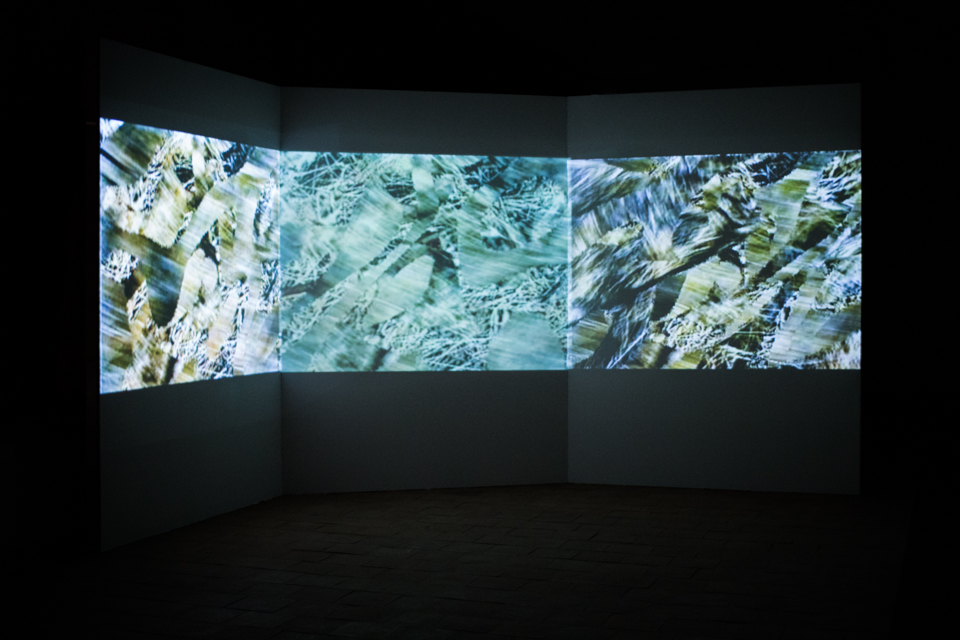Lava and Moss
Steina Vasulka
17.03. – 01.05.16
Steina Vasulka (born in Reykjavík in 1940) is an Icelandic artist, author of multichannel video installations and audio-visual performances. She studied violin and played with the Iceland Symphony Orchestra. At the end of 1950s, she decided to study in Prague where she met Bohuslav, later known as Woody, Vasulka, a film maker, with whom she went to the USA in 1965. The Vasulkas duo started to explore video art as the first pioneers in the field. Together they founded The Kitchen, the theatre of electronic media, in New York in 1971 and later also in Buffalo. They focused on experimenting with audio-visual relationships in a moving picture. In the mid-1970s, their artistic path had split although they would still share studios and tools. Steina created series of installations Machine Vision and Allvision; she used cameras on mobile tripods and mirroring objects to explore a possibility of total, all-embracing machine vision.
In her performances Violin Power, Steina used variously modified violins to control the image sequences. After moving to Santa Fe in 1980, she started to focus on working with the landscape. In her audio-visual installations called environments, Steina combines recordings from New Mexico and Iceland. As is typical for the first generation of video artists, Steina participates in creating her own creative tools. She worked at an experimental electronic studio STEIM in Amsterdam in the 1990s where she developed together with Tom Demayer Image/ine, a software that works with image and sound.
Steina’s music education had a great influence on her work with images. When describing her work, people often refer to music compositions. That is because Steina approaches the moving pictures in the same way as she would approach playing the violin. In Lava and Moss (Hraun og Mosi) from 2000, we can see images of lava fields near the Icelandic harbour Hafnarfjörður. The images are manipulated in such a way that they seem to defy the laws of physics while creating new (more free and fluid) reality. As Steina describes: „My fascination with lava stems from my childhood when trolls and elves were part of common reality. I remember that when I stared at some lava field for long enough, it started to move and even produce sounds. Many years later, I took a strong mescal in Herdisarvik and I was able to recall not only my childhood memories but also great imagination that is connected to them. It’s a great challenge; to move the landscape that has been frozen and solid for many centuries; to get the landscape dancing. If there is god everywhere, his presence is definitely most obvious when you look at lava and moss. “
The structure of detailed images of the landscape is in the dialogue with the structure of the electronic image itself. This audio-visual polyphony creates an impression of continuous dynamic movement that is often paradoxical – as is a symbiosis of moist and soft moss with sharp cliffs of once hot liquid lava. It is believed the trolls and elves live here, under the lava projections covered with moss. Steina considers the landscape of Iceland and the south-west of the States as ghostly and beautiful – as if resisting the absorbing beauty. Sometimes she holds the camera upside down, another time she uses multiple cameras and she places them on mobile robotic devices, she slows down the images, she leaves them to mirror the objects and so on. It is almost as if she needed to thoroughly technologically filter the landscape before she can make it her own and use it further. While in her early work the filming process served as the theme itself (and the resulting video was a documentary of its origin), in her contemporary work these processes remain hidden. Steina views the recording and filming as improvisation and play (she uses solely her own shots), however, the post-production manipulation and use of audio-visual software (also sometimes designed by her) is a completely rational process of sound and image element synchronisation. Steina Vasulka’s work unites poetic beauty and technical precision with unprecedented lightness.
Text by Lenka Dolanová



